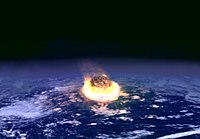
Photo from wikipedia
ABSTRACT The adakitic dikes with zircon ages of ~120–118 Ma are identified in the Xiejiagou gold deposit, Jiaobei terrain. The Early Cretaceous intermediate-acidic dikes include monzonite, quartz monzonite, and monzogranite,… Click to show full abstract
ABSTRACT The adakitic dikes with zircon ages of ~120–118 Ma are identified in the Xiejiagou gold deposit, Jiaobei terrain. The Early Cretaceous intermediate-acidic dikes include monzonite, quartz monzonite, and monzogranite, which have SiO2, Al2O3, K2O, Na2O contents ranging from 61.01 to 74.72 wt. %, 14.42 to 17.28 wt.%, 2.55 to 4.45 wt.%, and 3.09 to 4.64 wt.%, respectively. The dikes are enriched in large ion lithophile elements (LILEs) (e.g., Rb, Sr, and Ba) and light rare earth elements (LREEs), but are depleted in high field strength elements (HFSEs) (e.g., Nb, Ta) and heavy rare earth elements (HREEs). They are also characterized by continental crust-like isotopic compositions: whole-rock δ18O = 7.6–9.9‰, (87Sr/86Sr)i = 0.70893–0.71036, and εNd(t) = −13.16 to −17.06. Assimilation and fractional crystallization are limited, and partial melting of source rock is the main mechanism in controlling the compositional variation. The high Sr/Y (41.51–93.25) and (La/Yb)N (22.9–44.7) ratios imply that the dikes have affinities similar to adakitic rocks. The regional geological setting, coupled with the geochemical and isotopic data, indicate that the adakitic dikes were unlikely produced by partial melting of a subducted oceanic slab or a thickened/delaminated lower crust, or AFC processes of mantle-derived magmas. We conclude that the adakitic dikes are generated by partial melting of lower crust which was triggered and modified by underplating of the lithospheric mantle. We also propose that the eastern part of the North China Craton experienced severe thinning in the Early Cretaceous (~135–120 Ma), and the lithospheric thinning is related to delamination of the lower crust.
Journal Title: International Geology Review
Year Published: 2019
Link to full text (if available)
Share on Social Media: Sign Up to like & get
recommendations!